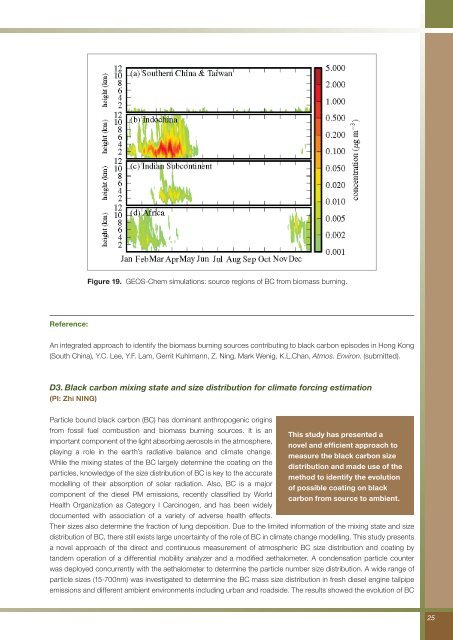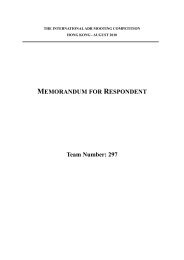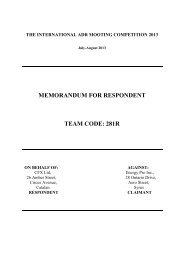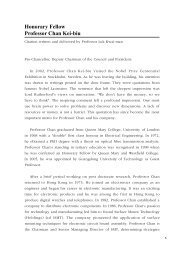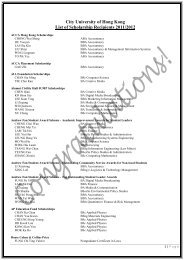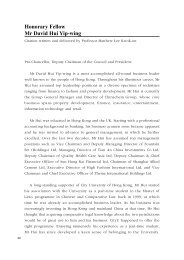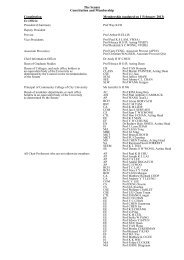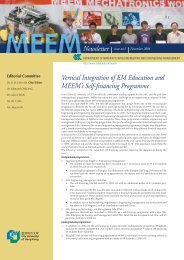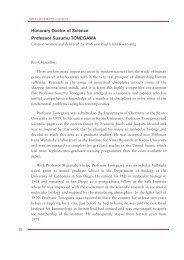Annual Report 2012 - City University of Hong Kong
Annual Report 2012 - City University of Hong Kong
Annual Report 2012 - City University of Hong Kong
You also want an ePaper? Increase the reach of your titles
YUMPU automatically turns print PDFs into web optimized ePapers that Google loves.
Reference:<br />
Figure 19. GEOS-Chem simulations: source regions <strong>of</strong> BC from biomass burning.<br />
An integrated approach to identify the biomass burning sources contributing to black carbon episodes in <strong>Hong</strong> <strong>Kong</strong><br />
(South China), Y.C. Lee, Y.F. Lam, Gerrit Kuhlmann, Z. Ning, Mark Wenig, K.L.Chan, Atmos. Environ. (submitted).<br />
D3. Black carbon mixing state and size distribution for climate forcing estimation<br />
(PI: Zhi NING)<br />
Particle bound black carbon (BC) has dominant anthropogenic origins<br />
from fossil fuel combustion and biomass burning sources. It is an<br />
important component <strong>of</strong> the light absorbing aerosols in the atmosphere,<br />
playing a role in the earth’s radiative balance and climate change.<br />
While the mixing states <strong>of</strong> the BC largely determine the coating on the<br />
particles, knowledge <strong>of</strong> the size distribution <strong>of</strong> BC is key to the accurate<br />
modelling <strong>of</strong> their absorption <strong>of</strong> solar radiation. Also, BC is a major<br />
component <strong>of</strong> the diesel PM emissions, recently classified by World<br />
Health Organization as Category I Carcinogen, and has been widely<br />
documented with association <strong>of</strong> a variety <strong>of</strong> adverse health effects.<br />
This study has presented a<br />
novel and efficient approach to<br />
measure the black carbon size<br />
distribution and made use <strong>of</strong> the<br />
method to identify the evolution<br />
<strong>of</strong> possible coating on black<br />
carbon from source to ambient.<br />
Their sizes also determine the fraction <strong>of</strong> lung deposition. Due to the limited information <strong>of</strong> the mixing state and size<br />
distribution <strong>of</strong> BC, there still exists large uncertainty <strong>of</strong> the role <strong>of</strong> BC in climate change modelling. This study presents<br />
a novel approach <strong>of</strong> the direct and continuous measurement <strong>of</strong> atmospheric BC size distribution and coating by<br />
tandem operation <strong>of</strong> a differential mobility analyzer and a modified aethalometer. A condensation particle counter<br />
was deployed concurrently with the aethalometer to determine the particle number size distribution. A wide range <strong>of</strong><br />
particle sizes (15-700nm) was investigated to determine the BC mass size distribution in fresh diesel engine tailpipe<br />
emissions and different ambient environments including urban and roadside. The results showed the evolution <strong>of</strong> BC<br />
25


